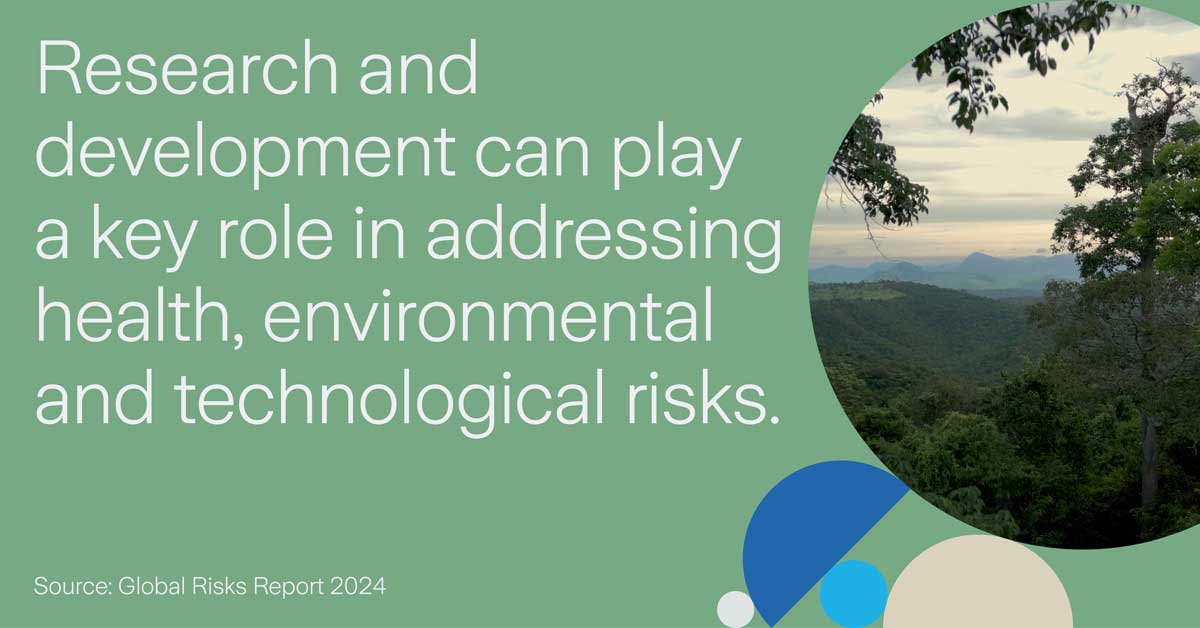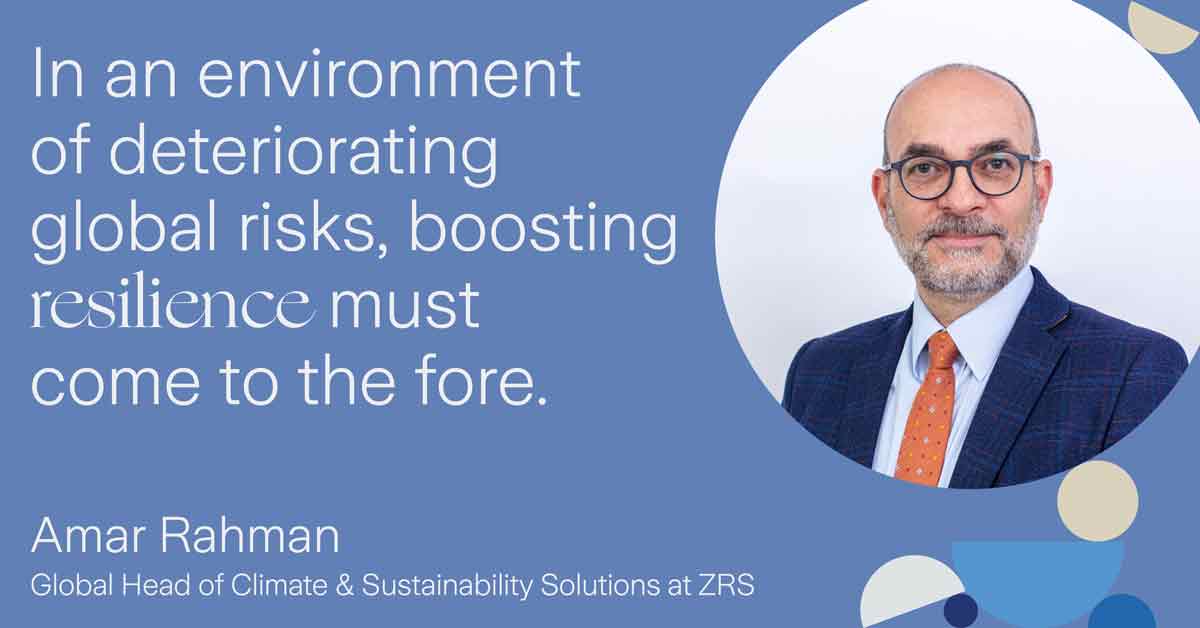Islands of resilience in a turbulent world
It’s hard to consider the risk outlook for this coming year and feel anything other than bleak. The sentiment is perhaps best summed up in this year's Global Risks Report (GRR) with the words: “a deteriorating global outlook.”
But amid the very real and urgent threats – from conflict spilling out of the Middle East to extreme weather to rampant misinformation – there are also stories of quiet, and effective, resilience. In the aftermath of the pandemic and Russia’s invasion of Ukraine, a widely predicted global recession did not take hold last year. Indeed, the GRR notes that “the global system has thus far proved surprisingly resilient.” At the same time, some much-needed progress is being made to decarbonize the global economy and restore damaged ecosystems.
Businesses cannot control the world in which they operate. An escalating conflict in Israel and Gaza cascades into Houthi rebel attacks in the Red Sea, disrupting supply chains into Europe. Low water levels caused by droughts linked to climate change disrupt shipping in the Panama Canal. These are examples of how today’s interconnected risks play out in reality. Faced with uncertainty and unpredictable events, organizations can respond in advance by building resilience within their own supply chain strategies and operations. With this in mind, it’s worth exploring examples of global resilience to better understand the insights they offer for those involved in managing and mitigating risks.
Islands of resilience
The pandemic and Ukraine conflict have had wide-ranging impacts on geopolitics and geoeconomics, including an energy crisis, a cost of living crisis and inflation at levels not seen in the G7 countries since the 1970s.
Swift central bank responses, however, especially by the Fed in the US, have led to “the perception of a ‘softer landing,’” as the GRR notes. “Inflation is falling amid tight labor markets with stronger-than-anticipated consumer spending and growth, particularly in the United States.” But if both inflation and interest rates stay elevated for longer, they may potentially compound supply-side cost-of-living pressures and debt loads for the public and private sector alike.
Turning to another major theme this year, there can be no better metaphor for resilience than the natural world. Damaged ecosystems can rebound and recover. One inspiring example lies in the Atlantic Forest in South America, where jaguars are coming back from the brink of extinction in Brazil thanks to efforts to enhance restoration. Just as species co-exist in intricate and interdependent webs – from plants to predators – so, too, do risks. A holistic view is needed, mapping the connections between threats.

Nature risks are tightly connected to a nexus of factors, including climate change and natural resources such as water. One promising example of companies living their sustainability objectives lies in industries with heavy reliance on ground water in their production processes. Based on climate change studies mapping precipitation levels, temperatures, demographics and other data, companies are already coordinating future water usage with local communities. Companies are also improving water usage efficiencies, through technological innovations, improved processes and new products.
COP’s role in the path to resilience
Last year’s COP28 summit was a milestone for the role of insurance as a key partner for climate resilience solutions. For the first time, the role of insurance in strengthening resilience and adaptation featured prominently, and the discussions were robust and nuanced. The global goal on adaptation (GGA) is an important one for insurers, with the final text of the agreement calling for a doubling in adaptation finance. More clarity on this will be required from COP29 later this year.
COP28 put emphasis on strategies for adapting to the impacts of climate change, with a significant number of events highlighting how locally-led adaptation initiatives have been developed and implemented across sectors and industries, many through public-private partnerships. Promising approaches include a rise in community initiatives to provide renewable power as well as an increase in practical public-private partnership initiatives. For example, the Insurance Development Forum (the IDF), spotlighted groundbreaking initiatives that demonstrate tangible solutions for tackling the climate crisis, including country-led implementation through the Tripartite Agreement, support for the Global Shield against Climate Risks, and launch of the IDF-convened Resilient Planet Data Hub. The IDF is a public-private partnership, chaired by Zurich’s Chairman Michel Liès, that aims to boost the role of insurance and its related risk management capabilities to build greater resilience and protection for people, communities, businesses, and public institutions that are vulnerable to disasters and their associated economic shocks.
The speed and scale of adaptation unquestionably needs to increase to keep risks manageable. Evidence proves that countries with a greater penetration of insurance coverage have faster economic recoveries from disasters and rebuild with greater resilience to future disasters. Research shows that a 1 percent increase in insurance penetration can reduce the disaster recovery burden on taxpayers by up to 22 percent.
Efforts to improve global resilience and address the protection gap have historically been primarily driven by a handful of public-private stakeholders. Given the scale, scope and complexity of the resilience and protection gap challenge, a coordinated and collaborative approach bringing together the insurance industry and all relevant stakeholders, both public and private, is critical to meeting the needs of climate-vulnerable communities.
Nurturing health resilience
However turbulent the world feels right now, it’s bracing to consider a counterfactual: What if scientists were still struggling to develop a Covid vaccine? While the trauma of the pandemic lingers and the hard truth remains that another pandemic could break out at any time, it’s worth reflecting on what the world got right last time.
According to the GRR, Research & Development “can play a key role in addressing health, environmental and technological risks.” Pharmaceutical companies were able to develop a Covid shot in record time because they were building on pre-existing and pioneering work into mRNA vaccine technology. Cooperation between government, academia, and business also played a crucial role. The subsequent roll-out of the vaccine prevented an estimated 14 – 20 million deaths and untold economic damage, a striking example of innovation and collaboration working in concert to build resilience.

The good news
As these examples all show, risk management is a dynamic and multi-faceted exercise. In an environment of deteriorating global risks, boosting resilience must come to the fore. This encompasses mapping, mitigating and responding to external threats, from climate change to strains on the supply chain.
The good news is that while global risks may be beyond our control, every organization can play its part in building resilience.

Climate Resilience
Our Climate Resilience experts help you identify and manage climate risks, and prepare you for climate reporting.

Commercial Insurance Risk Insights
Our experts share their insights on the current risk landscape to help you address and manage emerging risks.